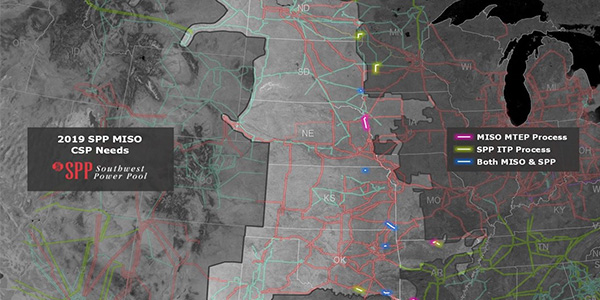By Amanda Durish Cook
SPP and MISO staff and stakeholders recommended performing a coordinated system plan in 2019-20 that will study six possible sites for interregional transmission projects.
The RTOs announced the recommendation during their Feb. 26 Interregional Planning Stakeholder Advisory Committee meeting, which served as their annual review of congestion issues.
MISO Expansion Planning Engineer Ben Stearney said both “staffs are fully in support” of the study, which was approved by stakeholders on the conference call.
The recommendation still needs approval from the MISO-SPP Joint Planning Committee, which is composed of planning staff from both RTOs. The committee will meet sometime in March to hold the vote. If the JPC approves, the RTOs will begin working on building the scope of the CSP.
The study could result in a first-ever interregional transmission project for the RTOs, which conducted CSP and regional reviews in 2014 and 2016 but were unable to reach an agreement on any projects.
So far, the RTOs’ studies show that they may need transmission projects along multiple spots near their southern seam in addition to a location on the South Dakota-Iowa border.
The six possibilities for joint economic projects are:
- The Neosho-Riverton 161-kV line on the Kansas-Missouri border, which also appeared in the RTOs’ 2016-17 CSP study;
- A circuit on the Kerr-Maid 161-kV double-circuit line in northeast Oklahoma, needed for west-to-east bulk transfers;
- The 138-kV South Shreveport-Wallace Lake line in northwest Louisiana, where the area is experiencing load growth;
- The 345-kV Hugo-Valliant line in southern Oklahoma, the loss of which causes overloads on the nearby 138-kV system;
- A 230-kV line in Sioux City, where MISO predicts that growing wind generation in South Dakota will drive up north-to-south flows; and
- The 115-kV Marshall-Smittyville line in northern Kansas, needed as a generation corridor.
If approved, the CSP would be the first in which MISO and SPP rely on their individual regional processes instead of a joint model to evaluate potential transmission projects.
Some stakeholders asked MISO and SPP for a special study of the seam’s most expensive flowgates to see if the RTOs could identify needs that the separate regional processes might be missing. A few said some of the most costly flowgates don’t seem to be captured in the models.
But MISO and SPP staff said a special joint study would introduce more hurdles and negate last year’s decision that the joint model was too cumbersome and ineffective at identifying projects. “To me that was part of the decision-making in 2018 that led to where we are … that we won’t do anything separate and one-off,” SPP’s Adam Bell said.
“I support the study, but I disagree with what we’re looking at,” said Omaha Public Power District’s Josh Verzal, one of the stakeholders who criticized the RTOs for not taking stakeholder-submitted project needs seriously enough.
The RTOs plan to make a FERC filing soon seeking approval for interregional process changes they agreed to last year. In addition to doing away with the joint model, they also agreed to eliminate a $5 million cost threshold for projects, add avoided costs and adjusted production cost benefits to project evaluation, and make CSP studies a more regular occurrence.
Last month, the RTOs said stakeholders and staff support an annual joint study of interregional transmission projects. Currently, their CSP is not mandated annually. (See MISO, SPP Pushing for Annual Joint Studies.)




